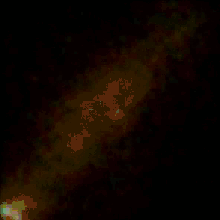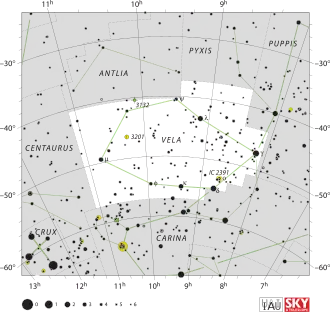PSR J0835-4510
Der Pulsar PSR J0835-4510, auch Vela-Pulsar genannt, liegt im Sternbild Segel des Schiffs. Er wurde 1968 entdeckt. 1977 konnte er als einer der wenigen Pulsare auch im optischen Bereich als Überrest einer Supernova identifiziert werden. Er ist Parsec (936 Lichtjahre) entfernt.[2] Er entstammt der Vela-Supernova; sie ist die räumlich nächstgelegene, die aus den bekannten Überresten der vergangenen 50.000 Jahre ermittelt werden konnte. Die Rotationsdauer des Pulsars beträgt 89 ms, ihre Zunahme 3,90 µs pro Jahr. Daraus folgt ein recht junges Alter von ca. 11.000 Jahren.

| Pulsar PSR J0835-4510 (Vela Pulsar) | |||||||||||
|---|---|---|---|---|---|---|---|---|---|---|---|
 | |||||||||||
| Vela Pulsar ist der helle Punkt in der Mitte, umgeben von einem Pulsarwind-Nebel, in dem Plasma-Stoßwellen und radial verlaufenden Jets erkennbar sind. | |||||||||||
 | |||||||||||
| AladinLite | |||||||||||
| Beobachtungsdaten Äquinoktium: J2000.0, Epoche: J2000.0 | |||||||||||
| Sternbild | Segel des Schiffs | ||||||||||
| Rektaszension | 08h 35m 20,66s [1] | ||||||||||
| Deklination | -45° 10′ 35,2″ [1] | ||||||||||
| Astrometrie | |||||||||||
| Entfernung [2] | Lj pc | ||||||||||
| Physikalische Eigenschaften | |||||||||||
| Andere Bezeichnungen und Katalogeinträge | |||||||||||
| |||||||||||
| AladinLite | |||||||||||
Der Vela-Pulsar strahlt nicht nur im sichtbaren und Mikrowellenbereich, sondern ist auch eine der stärksten Gammastrahlenquellen am Firmament. Das Spektrum entspricht dem eines thermischen schwarzen Strahlers mit einer Temperatur von 600.000 bis 1.000.000 K.
Mit etwa 800 Lichtjahren sind der Vela-Pulsar und Geminga etwa gleich weit von der Erde entfernt und damit die beiden erdnächsten bekannten Pulsare.
Weblinks
Einzelnachweise
- Vela Pulsar. In: SIMBAD. Centre de Données astronomiques de Strasbourg, abgerufen am 19. Oktober 2019.
- R. Dodson, D. Legge, J. E. Reynolds, P. M. McCulloch: The Vela Pulsar's Proper Motion and Parallax Derived from VLBI Observations. In: Astrophysical Journal. Band 596, Nr. 2, 2003, S. 1137–1141, bibcode:2003ApJ...596.1137D.